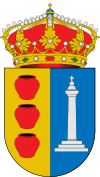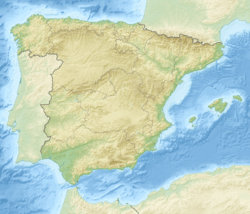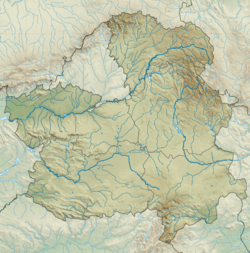Tinajas, Spain facts for kids
Quick facts for kids
Tinajas, Spain
|
|||
|---|---|---|---|

View of Tinajas
|
|||
|
|||
| Country | |||
| Autonomous community | |||
| Province | |||
| Municipality | Tinajas | ||
| Area | |||
| • Total | 46 km2 (18 sq mi) | ||
| Population
(2018)
|
|||
| • Total | 195 | ||
| • Density | 4.24/km2 (10.98/sq mi) | ||
| Time zone | UTC+1 (CET) | ||
| • Summer (DST) | UTC+2 (CEST) | ||
Tinajas is a small and charming municipality in Spain. It is located in the province of Cuenca. This province is part of the larger region known as Castile-La Mancha. Tinajas is a quiet place. It offers a glimpse into traditional Spanish village life.
In 2004, a count of people was done. This count is called a census. The INE reported that 370 people lived in Tinajas. By 2018, the population was 195 people. This shows that it is a very small community.
Contents
Discovering Tinajas
Tinajas is nestled in a beautiful area. It is surrounded by nature. The landscape here is typical of the Cuenca province. You can find rolling hills and open spaces. The area is perfect for exploring the outdoors.
Where is Tinajas Located?
Tinajas is in the eastern part of central Spain. It is part of the Castile-La Mancha region. This region is famous for its windmills. It is also known for its wide plains. The province of Cuenca is known for its unique geography. It has both mountains and valleys.
Geographic Features
The municipality covers about 46 square kilometers. This is roughly 18 square miles. The land is mostly rural. It has fields and some small forests. The elevation of Tinajas is not specified. However, the area generally has varied terrain.
What is a Municipality?
A municipality is a local government area. It is like a town or a small city. It has its own local council. This council makes decisions for the people living there. The mayor is the head of the council. They help manage local services. These services include things like roads and public spaces.
Local Government in Tinajas
Tinajas has its own local government. This government works to serve its residents. They manage local affairs. This includes things like public services and community events. Even small towns have important local leaders.
Life and Culture in Tinajas
Life in Tinajas is peaceful. It is a close-knit community. Many traditions are still important here. People often know their neighbors well. This creates a strong sense of community.
Local Traditions and Festivals
Like many Spanish villages, Tinajas celebrates local festivals. These events are very important. They often honor patron saints. Festivals usually include music, dancing, and special foods. They are a great way to experience local culture.
Community Gatherings
Community gatherings are common in Tinajas. These events bring people together. They help keep traditions alive. They also strengthen bonds between residents. These gatherings are often family-friendly.
Daily Life in a Small Spanish Town
Daily life in Tinajas is quiet. It is different from big cities. People might work in agriculture. They might also work in nearby towns. The pace of life is slower. This allows for a relaxed lifestyle.
Education and Services
For education, children from Tinajas might attend schools in larger nearby towns. Basic services are available locally. For more specialized needs, residents travel to larger centers in the province of Cuenca.
History of Tinajas
The history of Tinajas is linked to the wider history of Spain. Like many small towns, its past is shaped by different eras. These include Roman times and medieval periods. The area has seen many changes over centuries.
Historical Significance
Small towns like Tinajas often have a rich history. They might have old buildings or ruins. These structures tell stories of the past. They show how people lived long ago.
Ancient Roots
The name "Tinajas" might come from the Spanish word for "jars" or "large pots." This could suggest that pottery was once important here. Or it might refer to natural features that look like jars.
Exploring the Province of Cuenca
Tinajas is part of the Province of Cuenca. This province is known for its natural beauty. It also has historical sites. The city of Cuenca is its capital. It is famous for its "hanging houses."
Natural Beauty of Cuenca
The province offers many natural attractions. There are national parks and rivers. It is a great place for outdoor activities. These include hiking and exploring nature.
Famous Landmarks in Cuenca
The city of Cuenca is a World Heritage Site. Its hanging houses are built on cliffs. They are a unique sight. The city also has a beautiful cathedral.
Economy of the Region
The economy of the Cuenca province is varied. Agriculture is important. Tourism also plays a big role. Many people visit the area for its history and nature.
See also
 In Spanish: Tinajas (Cuenca) para niños
In Spanish: Tinajas (Cuenca) para niños





